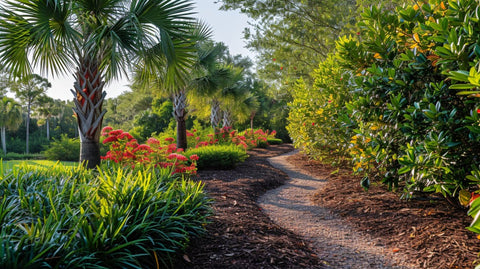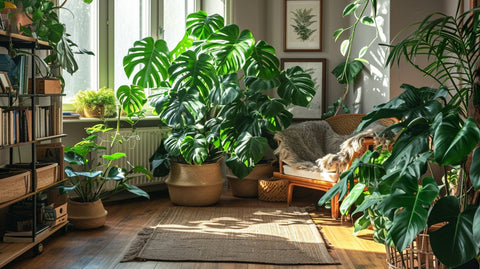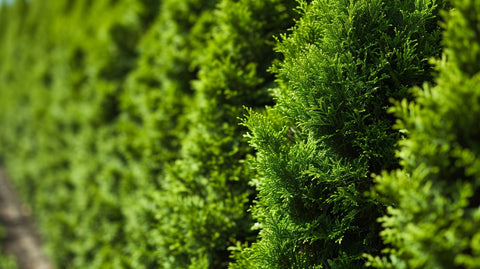native florida bushes
The Beauty and Benefits of Native Florida Bushes in Landscaping
Introduction

When it comes to landscaping in Florida, native bushes play a crucial role in creating a beautiful and sustainable outdoor space. These bushes are not only aesthetically pleasing but also offer a host of benefits that can enhance your overall landscape design. In this article, we will explore the importance of native Florida bushes and delve into the unique features they bring to your outdoor environment.
A Brief Explanation of the Importance of Native Florida Bushes in Landscaping
Native Florida bushes are essential for landscaping projects as they provide a sense of place and contribute to the overall beauty of the region. These bushes have adapted to the local climate and soil conditions over centuries, making them well-suited for Florida's unique environment. By incorporating native bushes into your landscape design, you can create a harmonious and natural-looking outdoor space that reflects the spirit of Florida.
Overview of the Benefits Native Bushes Can Provide
Native Florida bushes offer numerous benefits that go beyond their visual appeal. They provide habitat and food sources for native fauna, promote biodiversity, require less maintenance, and are more resistant to diseases and pests. Additionally, native bushes are drought-tolerant and can help conserve water, making them an environmentally-friendly choice for your landscaping needs.
The Unique Flora of Florida

Florida is home to a diverse range of native plants, including an array of unique bushes that thrive in the region's specific ecological niches. The state's native flora has a rich history dating back thousands of years, with plant communities that have evolved and adapted to various habitats, such as wetlands, coastal areas, and upland forests.
Brief History of Florida's Native Plant Communities
Before European settlement, Florida's landscape was dominated by a variety of plant communities, including pine flatwoods, hardwood hammocks, and salt marshes. These plant communities played a crucial role in maintaining the balance of the ecosystem and supporting native wildlife. However, with urbanization and the introduction of non-native species, many of these plant communities have been altered or destroyed.
Importance of Preserving and Promoting Native Plants
Preserving and promoting native plants, including bushes, is of paramount importance to maintain Florida's unique biodiversity and ecosystem. Native plants have co-evolved with local wildlife, providing essential food, shelter, and breeding sites. By choosing native Florida bushes for your landscaping projects, you actively contribute to the preservation of the state's biodiversity and the overall health of its ecosystems.
Why Choose Native Florida Bushes?

Adaptability to Florida's Climate and Soil Conditions
One of the primary reasons to choose native Florida bushes for your landscaping is their exceptional adaptability to the state's climate and soil conditions. These bushes have evolved to thrive in the hot and humid summers, as well as the mild winters of Florida. Their deep root systems make them resilient to drought conditions while ensuring efficient nutrient uptake from the soil.
Low-Maintenance and Disease-Resistant Characteristics
Native Florida bushes are known for their low-maintenance traits, making them ideal for busy homeowners or those who prefer a more hands-off approach to landscaping. These bushes have developed natural defense mechanisms against common diseases and pests found in the region, reducing the need for chemical interventions. By incorporating native bushes into your landscape, you can enjoy the beauty of nature without the excessive maintenance.
Ecological Benefits such as Supporting Native Fauna and Improving Biodiversity
Native Florida bushes play a critical role in providing habitat and food sources for native fauna, including birds, butterflies, and other pollinators. They offer shelter, nesting sites, and nectar-rich flowers that attract wildlife to your garden. By selecting native bushes, you contribute to the conservation of the state's unique wildlife and help maintain a healthy and diverse ecosystem.
Drought-Tolerance and Water Conservation Advantages
Water conservation is a top priority in Florida, where freshwater resources are limited. Native Florida bushes have adapted to the state's periodic droughts by developing water-efficient qualities, such as smaller leaves and deep root systems. By incorporating these bushes into your landscape, you can reduce water consumption and create a sustainable garden that thrives even during drier periods.
Top 5 Native Florida Bushes for Landscaping
Brief Descriptions and Characteristics of Each Bush
1. Saw Palmetto (Serenoa Repens)

The Saw Palmetto is a native bush with palm-like leaves that grow in clusters. It is known for its ability to tolerate a wide range of soil conditions, from sandy to well-drained. The Saw Palmetto produces berries that are rich in nutrients and have medicinal properties. It is a popular choice for naturalistic landscapes or as an accent plant in larger gardens.
2. Viburnum Suspensum (Viburnum Suspensum)

Walter's Viburnum is a versatile evergreen shrub with glossy leaves and fragrant white flowers. It thrives in both sun and partial shade, making it suitable for various landscape settings. This bush is a favorite among gardeners for its ornamental value and its ability to attract butterflies and birds. It can be used as a hedge, screen, or specimen plant in residential gardens.
3. Firebush (Hamelia patens)

Firebush is a vibrant native Florida bush that boasts stunning red-orange tubular flowers. It is a magnet for hummingbirds and butterflies, making it a popular choice for pollinator-friendly gardens. Firebush thrives in full sun and well-drained soil, adding a pop of color and visual interest to any landscape. It can be used as a focal point or mixed with other native plants to create a diverse and lively garden.
4. Beautyberry (Callicarpa americana)

Beautyberry is a deciduous bush known for its clusters of vibrant purple berries that persist into the winter months. It thrives in partial shade and well-drained soil. The berries, while not edible for humans, provide food for various bird species. Beautyberry is an excellent addition to woodland gardens or natural areas, where it adds a splash of color and attracts wildlife.
5. Coontie (Zamia integrifolia)

The Coontie is a unique native Florida bush with fern-like foliage that adds a touch of elegance to any landscape. It is a low-maintenance plant that is highly drought-tolerant and thrives in partial shade. The Coontie is a host plant for the rare Atala butterfly and is a valuable addition to butterfly gardens or naturalistic landscapes.
Benefits and Specific Uses of Each Bush in Landscaping
The Saw Palmetto, Walter's Viburnum, Firebush, Beautyberry, and Coontie offer a range of benefits and can be used in various ways to enhance your landscape design.
The Saw Palmetto is not only aesthetically pleasing but also provides natural habitat for wildlife. Its berries can be used for medicinal purposes and are an excellent source of food for birds and small mammals. This bush can be used as a specimen plant or as part of a wildlife garden.
Walter's Viburnum is a versatile bush that can be used as a hedge, privacy screen, or background plant in a garden. Its fragrant flowers attract butterflies, and its glossy leaves provide year-round interest. This bush adds a touch of elegance and beauty to any landscape.
Firebush is a showstopper with its vibrant red-orange blooms. It attracts hummingbirds and butterflies, making it a perfect choice for pollinator gardens. This bush can be used as a focal point or mixed with other native plants to create a dynamic and colorful garden setting.
Beautyberry's purple berries are a striking feature that adds visual interest to any garden. They provide food for birds during the winter months when other food sources may be scarce. This bush is an excellent addition to naturalistic landscapes and attracts wildlife with its vibrant berries.
Coontie's fern-like foliage adds an elegant touch to any garden. It is a versatile bush that can be used as a ground cover or as part of a woodland garden. The Coontie's drought-tolerance and low-maintenance characteristics make it an excellent choice for Florida landscapes.
Potential Considerations or Limitations for Each Bush
While native Florida bushes are generally well-adapted to the local climate and soil conditions, there are some considerations to keep in mind when incorporating them into your landscaping.
The Saw Palmetto can spread through underground stems and may require occasional control measures to prevent it from taking over a garden. However, this bush is an excellent choice for naturalistic landscapes or larger gardens where it can thrive without restrictions.
Walter's Viburnum may require occasional pruning to maintain its desired shape or size. Additionally, it can attract scale insects, which may require regular monitoring and treatment. Despite these considerations, this bush offers significant visual and ecological benefits in landscaping.
Firebush requires regular watering during its establishment period but becomes more drought-tolerant once established. It can be susceptible to scale insects, but the potential benefits it brings to pollinators and the overall aesthetic value outweigh these minor challenges.
Beautyberry may require additional care and pruning to maintain its neat appearance. Its berries may also be attractive to wildlife, which can lead to a decrease in their ornamental value. However, the vibrant berries and wildlife interactions it brings make it a unique and valuable addition to any garden.
Coontie is a slow-growing bush that may take some time to establish itself in a landscape. It is important to avoid overwatering and ensure the soil is well-drained to prevent root rot. With proper care, Coontie can thrive and contribute to the overall beauty of a garden.
Best Practices for Growing Native Florida Bushes
Site Selection and Soil Preparation
Before planting native Florida bushes, it is important to select an appropriate site and prepare the soil to ensure optimal growth and development. Choose a location with the appropriate sun exposure and soil conditions for the specific bush you are planting. Most native Florida bushes prefer well-drained soil, so it may be necessary to amend heavy clay soils with organic matter or sand.
Proper Planting Techniques
When planting native Florida bushes, it is essential to follow proper techniques to ensure successful establishment. Dig a hole that is slightly larger than the root ball of the bush and add compost or organic matter to the planting hole. Place the bush in the hole, ensuring that the top of the root ball is level with or slightly above the surrounding soil. Backfill the hole and gently firm the soil around the plant, ensuring there are no air pockets.
Watering and Irrigation Tips
Proper watering is crucial for the initial establishment of native Florida bushes. Water the bushes deeply immediately after planting and continue to water regularly until they are well-established. Once established, native bushes are generally drought-tolerant and require less watering. However, it is important to monitor soil moisture levels and provide supplemental irrigation during prolonged dry periods.
Pruning and Maintenance Guidelines
Native Florida bushes generally require minimal pruning and maintenance. However, it is important to prune them as needed to maintain their shape, remove dead or diseased branches, and promote air circulation. Pruning should be done during the appropriate time of year for each specific bush, as timing can influence flowering and fruiting. Regular monitoring for pests and diseases is also recommended, as early detection can prevent severe infestations.
Promoting Native Florida Bushes in Landscaping
Encouraging Local Nurseries to Carry Native Plant Varieties
One way to promote the use of native Florida bushes is to encourage local nurseries to carry a diverse selection of these plants. Local nurseries play a crucial role in providing access to and increasing the availability of native plant varieties. By supporting local nurseries that prioritize native plant stock, we can help create a demand for these bushes and pave the way for more sustainable landscaping practices.
Educating the Community about the Long-Term Benefits of Native Plants
Education is key to raising awareness about the importance and benefits of native Florida bushes in landscaping. By hosting workshops, seminars, or online resources, we can empower homeowners, landscapers, and garden enthusiasts with the knowledge and skills necessary to incorporate native plants into their outdoor spaces. Sharing success stories, highlighting the ecological benefits, and showcasing the beauty of native Florida bushes can inspire others to follow suit.
Supporting Local Initiatives or Organizations Focused on Native Flora Conservation
Supporting local initiatives or organizations that focus on the conservation and preservation of native Florida plants is another way to promote the use of native bushes in landscaping. These organizations work tirelessly to protect natural habitats, restore endangered plant populations, and educate the public about the value of native flora. By donating, volunteering, or participating in community events, we can contribute to the conservation efforts and ensure a greener, more sustainable future.
Conclusion
Native Florida bushes offer exceptional beauty, environmental benefits, and sustainability to your outdoor spaces. Their adaptability to the state's climate, low-maintenance characteristics, ecological advantages, and water conservation benefits make them an excellent choice for any landscaping project. By selecting native bushes, you not only enhance the aesthetics of your garden but also contribute to the preservation of Florida's unique plant heritage and support the region's biodiversity. So, why not embrace the beauty and benefits of native Florida bushes and create a sustainable landscape that will thrive for years to come?






























Comments (0)
There are no comments for this article. Be the first one to leave a message!